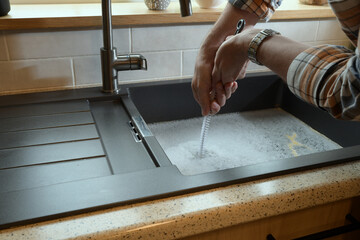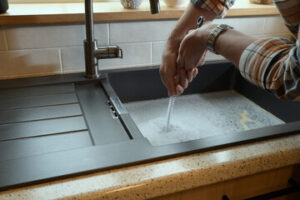Tankless Water Heater Atlanta use electricity or gas to heat water on demand, rather than keeping a tank full. They are safer and more energy efficient than tank-type units.
Installation of tankless units is a job for pros, since it involves updating your home’s water, gas and electrical systems. A professional will know the codes that must be met and obtain any necessary permits.

A tankless water heater costs more to install than a traditional tank model, but the upfront investment will save money in the long run by reducing energy bills. There are also tax credits available, which can help offset the initial cost. A qualified plumber will be able to advise you of the best model for your home and its specific requirements.
There are several factors that influence the price of a tankless water heater, including its capacity and type of fuel. Most importantly, a tankless water heater can only provide so much hot water at one time. If multiple appliances are running simultaneously, the demand will exceed the system’s ability to meet your home’s needs. This is why it’s important to carefully consider your family’s water usage and use a reputable professional to perform a load calculation.
Another consideration is the gallon per minute flow rate, which will affect how many faucets and appliances can be used at one time. The average household will need a two to three GPM unit, while larger homes will need higher flow rates of up to 10 GPM.
It’s also important to select a unit with the right fuel type for your home, such as gas or electric. Some manufacturers are known for producing high-quality tankless water heaters, and you should take the time to do your research. Rinnai, Rheem, and Noritz are among the most popular brands, offering both gas and electric models at a variety of prices.
Once you’ve chosen a unit, it’s important to hire a licensed plumber to complete the installation. This will ensure that your tankless water heater is installed properly and that it meets all codes and safety regulations. In addition, the plumber will be able to ensure that you receive any available rebates for your new water heater.
Before you hire a plumber, ask about their credentials and previous work. You should also check whether they are BBB-accredited and have a solid reputation in the community. Finally, be sure to get a written estimate before the project begins. This will give you a clear understanding of the costs involved and any additional charges that may occur.
Energy Efficiency
A tankless water heater is more energy efficient than a traditional Storage Tank Water Heater because it only heats water when you need it. However, if your home uses multiple hot water sources at the same time, such as a dishwasher and washing machine at the same time, a tankless water heater can struggle to keep up. The result is inconsistent hot water.
You can also expect to pay more for installation than with a traditional water heater, depending on the type of unit you choose and the work involved. For example, installing a new gas line increases the labor cost for gas-powered models. Installation costs can also vary based on the size of your home, as well as whether you want to install a point-of-use (POU) unit or a whole-home model.
The initial installation of a tankless water heater can run up to $500 or more. This includes the removal of your existing tank water heater, if necessary. It also includes labor, which is usually charged at an hourly rate by plumbers. The installation process can be more complicated than simply swapping out a new water heater for an old one, as it requires electrical upgrades and plumbing changes to accommodate the new system. For instance, if you’re installing a gas-powered unit, your plumber will have to install a new gas line, as well as venting and ventilation systems.
Moreover, if you’re installing a POU model, your plumber may need to insulate or reroute the hot water line. They’ll also have to modify the circuit breaker panel, as the old one won’t be able to support the demand of your new water heater. Finally, your plumber will need to install a new exhaust vent, which could be as simple as replacing the existing one or as complex as creating a whole-house venting system.
In addition to installation costs, you’ll also need to consider the yearly operating costs of a tankless water heater. The good news is that they’re typically more energy efficient than traditional tanks, and some of your yearly savings on utility bills should cover the cost of the unit. However, if you live in an area prone to power outages, a Tankless Water Heater can be problematic, as they require electricity to operate and regulate.
Installation
The installation of a Tankless Water Heater can be a complex process and requires specialized knowledge. It is therefore important to hire a professional plumber to ensure that the installation is completed properly and safely. Hiring a plumber with a high BBB rating and local recommendations is an excellent way to find a reputable service provider. In addition, hiring a licensed plumber will ensure that the work is performed according to local plumbing codes and regulations.
The first step in installing a Tankless Water Heater is choosing the right location. It is recommended that you install the unit in a well-ventilated area, such as a basement or utility room. In addition, the unit must be located away from hot water sources and metal pipes to minimize noise. The plumbing professional will determine the best location based on your home’s hot water needs and any local restrictions.
It is also important to prepare the installation site. This includes ensuring that there are adequate horizontal and vertical clearances and that the heater can be fastened to the wall. The professional will also install a gas shutoff valve and a sediment trap. Additionally, the professional will ensure that the water supply line and electrical connections are connected correctly. It is recommended that you use a voltage tester to verify proper grounding and follow all safety precautions when working with electricity. If you are unsure about any aspect of the electrical connections, it is best to consult with a professional electrician.
In some areas, it is necessary to have a permit for the installation of a tankless water heater. This typically involves a visit to a local regulatory agency and an inspection of the job. In addition, some municipalities offer rebates for the installation of a tankless water heating system. If you are eligible for a rebate, make sure that the plumber is aware of it and complies with all requirements.
It is important to read and follow the manufacturer’s instructions for the installation of a Tankless Water Heater. This will help you to avoid any complications and ensure that your water heater is installed according to the manufacturer’s specifications.
Maintenance
Keeping the cost of water heater repair to a minimum requires preventative maintenance. Regular cleaning and inspections by a qualified professional can help minimize the need for repairs and extend the lifespan of your tankless water heater. In addition, regular maintenance can help avoid expensive repairs or replacements that could lead to a financial strain for homeowners.
A clogged or blocked filter or drain on a tankless water heater can cost between $75 and $150 to fix. This can be caused by mineral buildup in your home’s pipes, or a problem with the airflow and ventilation of the unit. A professional can clean the filters and flush your system to remove clogs.
If your water heater is leaking, the average cost to repair it is $50 to $600. A leaky system can cause water damage to your property and increase energy costs. Leaks can be caused by faulty sensors, valves, or other components. The location of the leak can also affect the cost. Generally, it is more expensive to repair a leak located near the sewage or gas line than at another point in the system.
When a tankless water heater fails to turn on, it can cost between $150 and $400 to fix. This issue can be caused by a lack of gas, a defective thermostat, or problems with the ignition system and venting. In addition, the pilot light can fail if it is not properly maintained and cared for.
Many people assume that tankless water heaters don’t require any maintenance, but this is not the case. A tankless water heater should be serviced at least once every year, and twice yearly in areas with hard water. During the service, a technician will clean the water and air filters, test the combustion efficiency of the burner, check the error codes, and flush the system. In addition, the technician will inspect your pipes to ensure that they are free of rust and scale.


